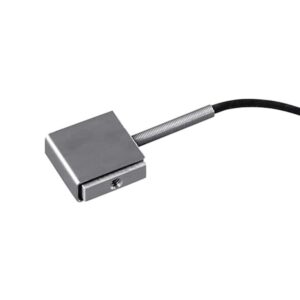Load sensors
A force sensor is a device that used to transform a physical quantity (temperature, pressure, position, concentration,etc.) into a signal (often electrical) that provides information about that quantity. For exeample, the pressure exerted by air on a needle on the scale corresponding to the measurement of this pressure. It is important to distinguish between a sensor and a measuring instrument. The sensor is an interface between a physical process and information. Sensors are adapted to various uses in different industrial environments: mechanical, measurement, electrical
ACRN offers the following configurations:
In S : it allows measurements in compression and traction. These sensors are designed to be less sensitive to parasitic forces.
With threaded hole : their shape is cylindrical with a low height, these sensors can be used in compression and traction. The central bore is tapped to facilitate the connection with the element that is to be controlled. They are generally used in laboratories for static or dynamic measurements but also in harsh industrial environments. Pancake load cells can measure from 25 to 500 000 daN depending on the model chosen.
Button type : cylindrical in shape with a central cylinder of smaller diameter to which a compressive force is applied. Button-type transducers are used primarily for general test and measurement applications, but also for monitoring and controlling machines such as packaging machines, assembly machines, or end-of-line testing equipment. These models can measure form 0.5 to 50,000 daN.
Showing all 5 results
-

Force transducer with stop SEJ-Z
-

High capacity force cell QJ & RJ
-

Mini SEJ-Z load cell with stop
-

Miniature compression cell FJ
-

S-Beam Loadcells SEJ
What is a force sensor ?
The force sensor is used to measure tensile or thrust stresses exerted on objects. This is done by using the elasticity of a test body often made of metal (aluminum, steel). This is therefore instrumented with (one or more) strain gauge that measures micro-strain as a function of load. The sensor is also used to evaluate the stresses exerted on an object.
How does it work ?
The conversion of a mechanical quantity into an electrical signal takes place in three steps on strain-gauge force transducers. The output point of a strain gauge force transducer is a test body on which strains are exerted at the material surface by external loads.
Elongation is detected by gauges applied on the surface of the test body. The gauges convert this mechanical stress into a variation of electrical resistance and behave like mechanical-electrical converters. The resistance variation allows them to generate a voltage variation proportional to the power. The intelligent interconnection of each strain gage in wheatstone bridge allows to detect even the smallest elongations.
Key benefits of strain gauge force sensors :
• Stain gauges are a proven and economical technology for force transducers
• High precision and exceptional linearity and hysteresis behaviour
• Possible measurement of static and dynamic loads
• High fatigue resistance due to sensor body materials and high vibration resistance of strain gauges
• Very good long-term stability
What are the most frequently used force sensors ?
The force sensor most commonly known is the piezoelectric. The word “piezo” comes from the Greek word for “squeeze”. The piezoelectric sensor produces a voltage when it is “squeezed” by a force that is proportional to the applied force.
However, there are also strain gauge sensors to measure forces up to several tons. Strain gauges are conductive grids whose resistance changes when they are stretched or compressed, allowing the force applied to the gauge to be measured, either in tension or compression. Strain gauges are particularly suitable for long-term monitoring tests.
How to choose the right load cell for your needs?
The choice of the sensor adapted to the need is not easy. Indeed, each type of sensor has its own particularities.
The nominal range is among the things to consider before choosing a load cell. Effectively, it determines the measurement capability of your device.
For example, a 100N sensor will have a measuring range of 100 newtons.
When purchasing a sensor, evaluation of measurement errorremains crucial. Thus, please take a close look at the data regarding nonlinearity, zero error, hysteresis and repeatability error. Analyzing these numbers also gives you an insight into the performance of a load cell.
It is also important to choose the device that fits your needs, sensitivity of the sensor and supply voltage remain to be examined. The electrical signal, connector, number of conductors, cable output, etc. are also to be checked.
Possible areas of application include test benches, for example for a force measurement to check the quality of a material and automated systems to check quality characteristics during processing or assembly.
ACRN can also offer these different sensor configurations on request.
Ring type: this cylindrical sensor has a central hole surrounded by a ring which allows to measure a compression force. This requires that the force be applied uniformly to the central ring in order to obtain accurate results. This type of sensor is typically used to measure clamping forces. Sensor models that can measure forces of 20 to 20 000 daN.
Canister type: this elongated cylindrical sensor can also measure high compressive loads. Instead, canister sensors are used in industry to measure high loads. Depending on the model, the canister force transducers have measuring capabilities of 1 000 to 150 000 daN.
Beam type: These sensors, generally rectangular in shape, are used to measure bending or shearing forces. They are very sensitive to parasitic forces (transverse force or torque for example) and require a very precise alignment to obtain accurate measurements. Beam type load cells can measure from 2 to 50 000 daN. They are generally used in the industry (weighing platform).
Online type: this sensor equipped with two aligned threads allows the measurement of tension or tension/compression forces. It has a measuring capacity of 20 to 10 000 daN Is also used in the weighing platform industry.
